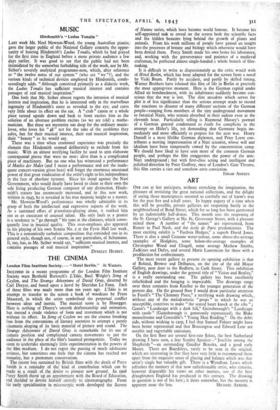ART
ONE can at last anticipate, without stretching the imagination, the pleasure of revisiting the great national collections, and the delight of seeing those masterpieces secreted so carefully out of harm's way for the past five and a-half years. In happy augury of a time when this will be possible, private galleries are reopening busily in the neighbourhood of Bond Street, which for so long has been garrisoned by an indomitable half-dozen. This month sees the reopening of the St. George's Gallery at No. 8i, Grosvenor Street, with a pleasant mixed show. A number of " the names " are represented, from Renoir to Paul Nash, and the ecole de Paris predominates. The most exciting exhibit is " Fuchsia Hedges," a superb David Jones. There is also a small Cezanne water-colour, some above-the-average examples of Hodgkins, some below-the-average examples of Christopher Wood and Chagall, some average Mathew Smiths, Zadkines and Dufys, and several Marie Laurencins for those with a predilection for confectionery.
The most recent gallery to present its opening exhibition is that of Roland, Browse and Delbanco, on the site of the old Mayor Gallery, next door to the Redfern, in Cork Street. This exhibition of English drawings, under the general title of " Vision and Reality," is a really outstanding- one. The gallery has been excellently refurbished and the hanging is impeccable. The drawings range over three centuries from Kneller to the younger generation of the present day. On the ground floor I would draw particular attention to Fuseli's "The Chimney Piece," a terrifying wash drawing which,, without any of the melodramatic " props " to which he was so susceptible, contrives to make " the seated heart knock at the ribs " ; Cozen's " Landscape with a dark hill," Gainsborough's " Landscape with castle" (Gainsborough is generously represented), the Blake monochrome and Constable's "Young Man Reading." On the debit side, without wishing to carp, I feel that Samuel Palmer might have been better represented and that Bonnington and Edward Lear are notable and regrettable omissions.
On the first floor are several first-rate johns, the best Sutherland drawing I have seen, a ,fine Stanley Spencer—" Joachim among the Shepherds "—an outstanding Gaudier Brzeska, and a good early Moore. There are Beardsleys, rarely to be seen in the original, which are interesting in that they have very little to recommend them apart from the exquisite sense of placing and balance which was that artist's single but valuable gift. There is a Wyndham, Lewis which refreshes the memory of that now unfashionable artist, who remains, however disputable his views on other matters, one of the best diaughtsmen England has produced in this century. The drawing in question is not of his best ; it dates somewhat, but the mastery is


























 Previous page
Previous page